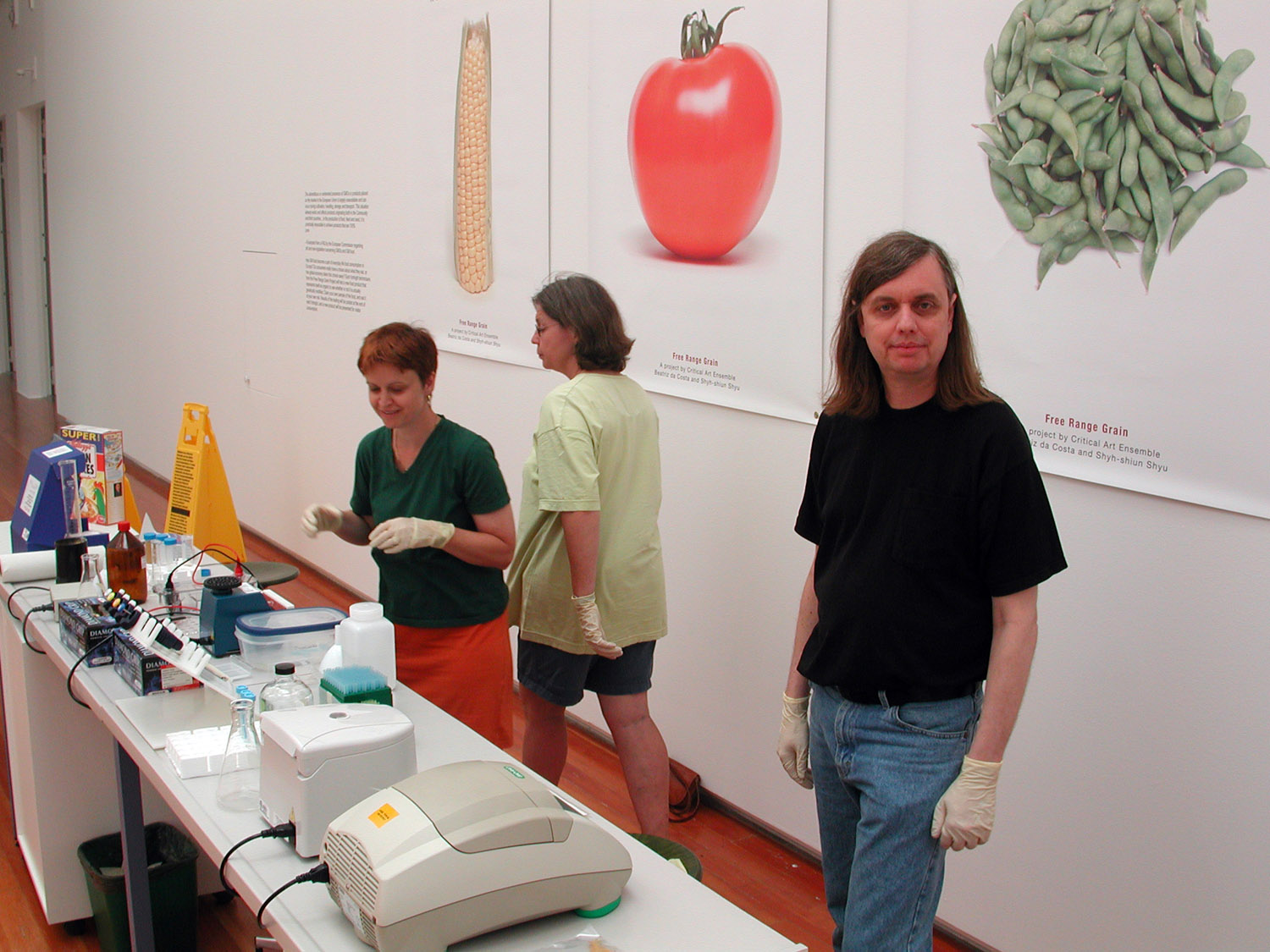How Critical Art Ensemble Pioneered Bio Art

Steve Kurtz from Critical Art Ensemble in 2004
“The US has never been a good place to be if you are an artist,” says Critical Art Ensemble, “particularly one concerned with the political dimension of cultural production.” If there ever was a group of artists dedicated to using their art practice to address the political dimension, it’s Critical Art Ensemble. The group received a Creative Capital Award in 2002 for their project, GenTerra, which used performance and bioengineering to help stimulate a more engaged and informed public discourse happening at the time around Genetically Modified Organisms (GMOs). In its support of the artist collective, Creative Capital went on a journey with them, telling a unique story about how we work with artists.
“The situation at that time was quite bleak,” Critical Art Ensemble (CAE) told us, speaking about the contemporary conversation around GMOs. “On the one hand was the corporationist position, which argued that whatever potentially profitable GM product could be engineered should be engineered, and any potential problems could be fixed as they occurred.” On the other hand, people took a “green position” which held that all GMOs should be banned until studies could be conducted over time. While the latter plan was “notably far less reckless,” it was a moot argument, according to CAE: “the genie was out of the bottle.” CAE took an unoccupied middle-ground stance—”these new products had to be taken on a case-by-case basis.” To push the conversation and inform the public, CAE began working on GenTerra.
Critical Art Ensemble’s history is a key reminder about why Creative Capital was established in the first place—too few organizations still support artists making adventurous, and maybe even controversial work.
The question was how to engage an audience whose attention might be lost when confronted with the concept of GMOs. The collective decided to use people’s growing fear of bacteria and GMOs in order to transform it into informed concern. CAE created what they called a “transgenic” bacteria, that was actually a strain of E. coli, not a type that makes humans ill. There was nothing dangerous about it: they severely crippled the strain and injected it with small pieces of DNA. “The DNA couldn’t express anything, but we could still say that the bacteria had human DNA in it, and then let people draw their own conclusions, which were often very anxiety ridden,” said CAE.
This new bacteria became the center of a public installation, in which an audience was informed they could release the bacteria themselves into the space they were occupying or take the bacteria home with them. The choice that CAE gave their audience prompted people to spend “serious amounts of time discussing and poring over supplied information on GMOs and risk assessment in order to decide” what to do. At an iteration in Manchester, UK, the London Arts Council did exit polls and found that the viewers understood the concepts well, and retained what they had learned. CAE told us that “kids especially loved streaking the petri dishes, and taking them home to watch them grow.”

Beatriz da Costa performs as part of Critical Art Ensemble’s GenTerra
Creative Capital has always supported art that takes risks and pushes boundaries, and in 2004, the organization was put to the test test when CAE member Steve Kurtz was detained for bioterrorism after discovery of the collective’s lab equipment. The FBI confiscated the equipment the collective used to make these harmless bio-artworks. A court cleared Kurtz of all charges, but it took four years and a quarter million dollars to get to that verdict. “Creative Capital immediately gave us the money to replace everything we lost so we didn’t lose any production time or distribution opportunities, and, in addition, funds for a down payment on Steve’s lawyer,” CAE said. “We have to give a personal shout out to Ruby Lerner,” referring to Creative Capital’s founding director. “You don’t mess with one of her grantees, and think there won’t be any push back. So many folks at Creative Capital helped us, but Ruby really went beyond the call of duty.”
CAE’s practice and history is a key reminder about why Creative Capital was established in the first place—too few organizations still support artists making adventurous, and maybe even controversial work. When prompted with the idea that the government is making it harder to be an artist, rather than easier, CAE responds that it’s never been easy to be an artist in this country.
“For most of the 20th Century, art was just a folly, and why would anyone other than those elites involved in the patronage and investment systems want anything to do with it? But at the close of the century, when it was clear the right was losing the culture war, the right (particularly the evangelicals) really started to take an interest, and this interest has continued and expanded. Steve Kurtz was not the only artist arrested during the Bush years. Trump’s insight has been ‘It’s the culture, stupid.'”
“The economy is to be considered,” they continued, “but it’s culture that makes people angry and fearful, and turns them out to vote. Consequently, anywhere progressive culture can be hindered, suppressed, or disappeared, it’s being done, although only with modest success. The militancy of progressive culture seems to come and go. CAE has seen this cycle completed a few times.”
Read more about Critical Art Ensemble on their website.
